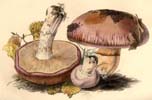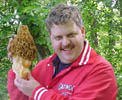George Herriot Cunningham (1892 - 1962)
Back to Author Index
Biography
Sources
Further Sources
Selected publications
Biography
Cunningham started out as an agricultural worker in Palmerston, New Zealand, where he worked in the cultivation of fruit and as a temporary third grade instructor.
1918 appointed schoolteacher
1920 studies biology and chemistry at the University of New Zealand in Wellington
1923 earns bachelor of science
1925 earns masters degree
1927 earns PhD for his work on the Gasteromycetes of Australia and New Zealand
For what it's worth, I have also seen his middle name spelled with two "t"s at the end.
Back to top
Sources
Heinrich Dörfelt & Heike Heklau (1998) Die Geschichte der Mykologie
(Die Geschichte der Mykologie)
Back to top
Further Sources
John Ramsbottom (1964) "Cunningham obit" in Biographical Memoirs of the Royal Society
Back to top
Selected Publications
George Herriot Cunningham (1923) "The Uredinales, or rust fungi, of New Zealand: I. Pucciniaceae, tribe Puccineae" in Transactions and Proceedings of the New Zealand Institute 54 pp. 619 - 704
George Herriot Cunningham (1924) "The Uredinales, or rust fungi, of New Zealand: Second supplement to the Uredinales of New Zealand" in Transactions and Proceedings of the New Zealand Institute 55 pp. 392 - 396
George Herriot Cunningham (1924) "The Gasteromycetes of Australasia: A critical revision of the Australian and New Zealand species of the genus Secotium" in Proceedings of the Linnaean Society of New South Wales 49:2 pp. 97 - 119
George Herriot Cunningham (1924) "The Ustilagineae, or smuts of New Zealand" in Transactions and Proceedings of the New Zealand Institute 55 pp. 397 - 433
George Herriot Cunningham (1924) "The Uredinales, or rust fungi, of New Zealand: Supplement to part I; and part II" in Transactions and Proceedings of the New Zealand Institute 55 pp. 1 - 58
George Herriot Cunningham (1925) "The Gasteromycetes of Australasia: II. A revision of the genus Tulostoma" in Proceedings of the Linnaean Society of New South Wales 50:3 pp. 245 - 258
George Herriot Cunningham (1925) "The Gasteromycetes of Australasia: III. The genera Bovista and Bovistella" in Proceedings of the Linnaean Society of New South Wales 50:4 pp. 367 - 373
George Herriot Cunningham (1926) "The Gasteromycetes of Australasia: IV. Species of the genus Geaster" in Proceedings of the Linnaean Society of New South Wales 51:2 pp. 72 - 93
George Herriot Cunningham (1926) "The Gasteromycetes of Australasia: V. The genus Calvatia" in Proceedings of the Linnaean Society of New South Wales 51:3 pp. 363 - 368
George Herriot Cunningham (1926) "The Gasteromycetes of Australasia: VI. The genus Lycoperdon" in Proceedings of the Linnaean Society of New South Wales 51:4 pp. 627 - 642
George Herriot Cunningham (1926) "Third supplement to the New Zealand Uredinales and Ustilaginaceae" in Transactions and Proceedings of the New Zealand Institute 56 pp. 74 - 80
George Herriot Cunningham (1926) "Fourth supplement to the Uredinales and Ustilaginaceae of New Zealand" in Transactions and Proceedings of the New Zealand Institute 57 p. 186
George Herriot Cunningham (1927) "The Gasteromycetes of Australasia: VIII. The genus Mycenastrum" in Proceedings of the Linnaean Society of New South Wales 52:3 pp. 245 - 246Mycenastrum N. A. Desvaux is still a good genus
George Herriot Cunningham (1927) "The Gasteromycetes of Australasia: VII. The genera Disciseda and Abstoma" in Proceedings of the Linnaean Society of New South Wales 52:3 pp. 235 - 244Believe it or not, both of these seem to still be good genera. Abstoma was in fact declared by Cunningham.
George Herriot Cunningham (1927) "The Gasteromycetes of Australasia: IX. Keys to the genera and species of the Lycoperdaceae" in Proceedings of the Linnaean Society of New South Wales 52:3 pp. 247 - 257
George Herriot Cunningham (1927) "Fifth supplement to the Uredinales and Ustilaginaceae of New Zealand" in Transactions and Proceedings of the New Zealand Institute 58 pp. 47 - 50
George Herriot Cunningham (1927) "The Polyporaceae of New Zealand" in Transactions and Proceedings of the New Zealand Institute 58:3 pp. 202 - 250
George Herriot Cunningham (1928) "Sixth supplement to the Uredinales and Ustilaginaceae of New Zealand" in Transactions and Proceedings of the New Zealand Institute 59 pp. 491 - 505
George Herriot Cunningham (1930) "Seventh supplement to the Uredinales and Ustilaginaceae of New Zealand" in Transactions and Proceedings of the New Zealand Institute 61 pp. 402 - 418
George Herriot Cunningham (1931) "The Gasteromycetes of Australasia: XII. The genus Scleroderma" in Proceedings of the Linnaean Society of New South Wales 56:4 pp. 277 - 287
George Herriot Cunningham (1931) The rust fungi of New Zealand together with the biology, cytology and therapeutics of the Uredinales 261 pp.
George Herriot Cunningham (1931) "The Gasteromycetes of Australasia: X and XI. The Phallales" in Proceedings of the Linnaean Society of New South Wales 56:2 pp. 1 - 15
George Herriot Cunningham (1931) "The Gasteromycetes of Australasia: XIII. The genus Pisolithus" in Proceedings of the Linnaean Society of New South Wales 56:4 pp. 288 - 291
George Herriot Cunningham (1932) "The Sclerodermaceae of New Zealand" in Transactions and Proceedings of the New Zealand Institute 62:2 pp. 115 - 119
George Herriot Cunningham (1932) "The Gasteromycetes of Australasia: XV. The genera Mesophellia and Castoreum" in Proceedings of the Linnaean Society of New South Wales 57:5 pp. 313 - 322Mesophellia Berkeley and Castoreum Cooke & Massee are still on the books as good genera, but I wonder if that'll hold up: if you look at the people who declared them, it's obvious that this was done without first-hand knowledge of the fungi. Mesophellia has three official species, all from Australia, and all most recently described from this paper. Castoreum is in a similar state.
George Herriot Cunningham (1932) "The Gasteromycetes of Australasia: XIV. The Family Tulostomataceae" in Proceedings of the Linnaean Society of New South Wales 57:1 pp. 27 - 39
Back to top











